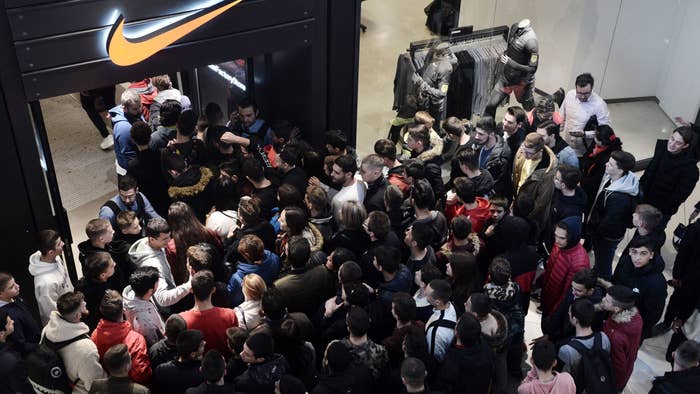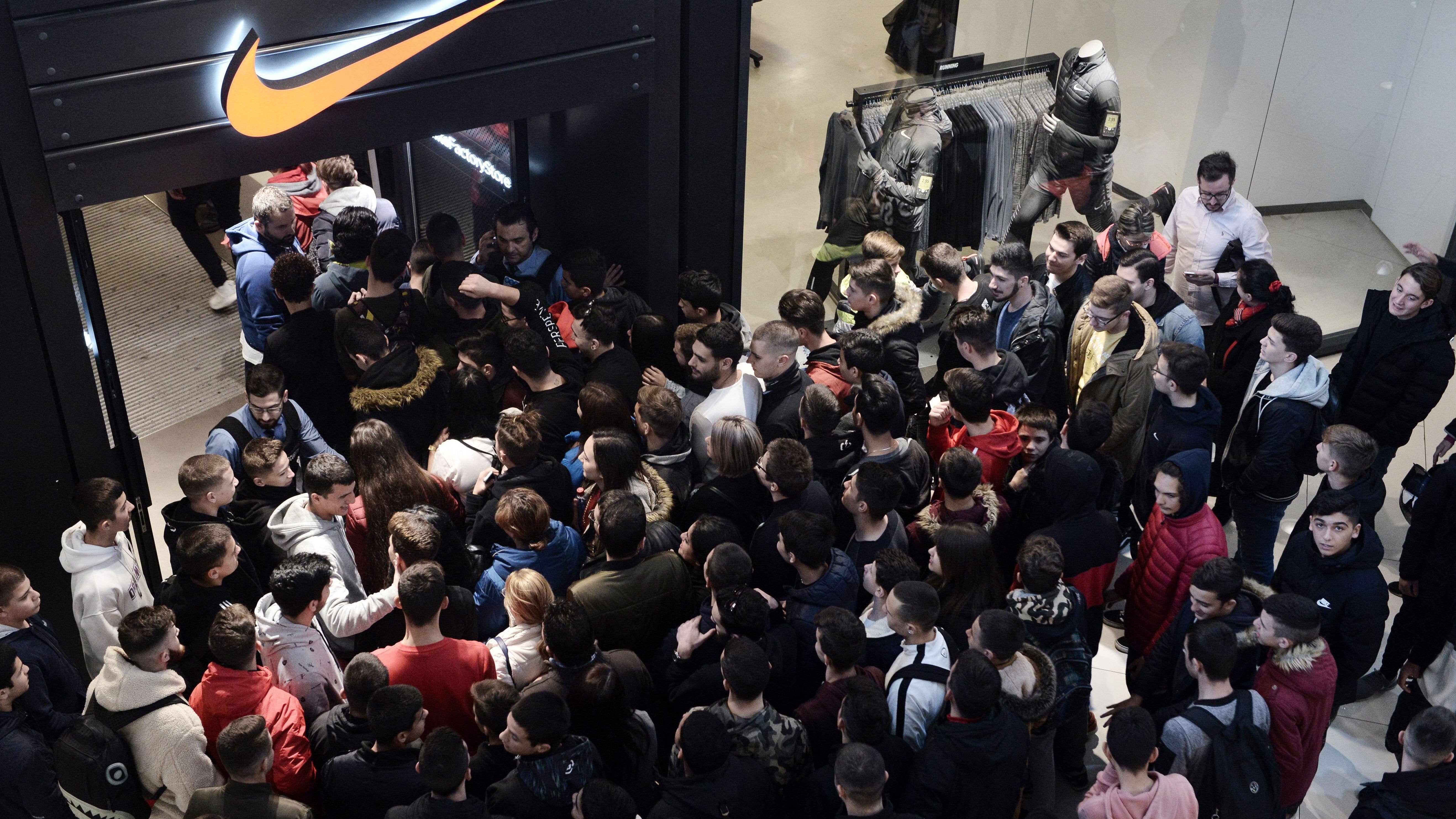
Nike has updated its rules for how retailers in North America carrying its most coveted shoes are allowed to release them, according to a confidential document from the brand that was viewed by Complex. This latest version of Nike’s North America product launch policy, from this month, spells out what the brand’s partner accounts are and aren’t allowed to do when it comes to selling Nike products.
“Nike and its [marketplace partners] must distribute launch product through an orderly process that avoids marketplace disruption, inventory diversion, and reseller profiteering,” the policy reads.
The updated Nike North America product launch policy was distributed to retailers toward the end of February.
In a statement to Complex this week, Nike confirmed that it had made changes to the policy.
“Nike recently updated its product launch policy in North America (U.S. and Canada) to ensure a consistent approach to marketing, distribution, and sale of launch product across marketplace partner channels,” the brand said. “Nike takes consumer experiences and protection extremely seriously and has updated its product launch policy to support orderly distribution and prioritize authentic consumer access to Nike product.”
Many of the guidelines in the launch policy are not new or particularly revealing—there are stipulations around not selling to resellers and preventing bots from compromising launches, for example, that reflect Nike’s public-facing stances. Still, it codifies exactly how stores in North America are expected to handle general release and more limited edition drops.
The policy doesn’t cover all Nike product, just “launch product,” which is defined as items that are tied to specific release dates. Stores are not allowed to sell these products before their release dates.
There are two different tiers of launch product—“high heat” and “general release”—for which two different sets of rules apply. General release is launch product that is “common and widely distributed,” whereas high heat is launch product that is “particularly scarce or highly coveted by consumers,” per the launch policy. High heat product can include collaborations or quickstrike releases.
The rules for launching high heat product are stricter than they are for general release product.
Nike’s product launch policy permits general release product to be sold to customers on a first come, first serve basis. But high heat launch product, the policy says, should only be sold first come, first serve if a store can’t host the launch via a random drawing. Further, a store can only release high heat launch product first come, first serve if it’s able to do so “in an orderly manner.”
The launch policy makes it clear that random drawings are the preferred method of launch for high heat product. Stores are allowed to release high heat product through an online drawing where winners buy the item in-store, an in-store drawing where winners purchase the item in-store, or an online drawing where winners purchase the item online.
Stores are required to set a time period for drawing entries that is no less than an hour, and entries must be limited to one per customer.
Winners are to be selected, per the policy, by a random process that is disclosed to customers. Stores are allowed to set a “reasonable deadline” for winners to claim their items and buy them before the store cancels winning draws for unclaimed entries.
Nike retail partners are prohibited from selling tickets or entries to drawings for launch product. They are allowed to provide entry into drawings in exchange for charity donations, but only with prior written approval from Nike.
Nike retail partners are prohibited from requiring consumers to buy another product at the store in order to gain entry to a drawing for a launch product. Stores are not allowed to bundle launch products with other items and require customers to buy other products in order to gain access to launch product.
Stores aren’t allowed to use launch product as prizes for promotions or contests. As an example, Nike’s launch policy says that stores can’t offer launch product in exchange for customers signing up for a membership program. Stores are prohibited from offering sneakers as prizes even in connection with charities, unless they’ve received written approval from Nike.
Nike retail partners are prohibited from selling launch product to commercial resellers, and are meant to sell launch product only to people for their personal use. The product launch policy doesn’t have any guidelines for how stores should weed out resellers at launches.
Stores that are permitted to sell high heat launch product online must have commercially reasonable bot deterrence measures in place, the launch policy says.
“Bot deterrence services should be activated to block suspicious drawing entries and purchases from individual accounts or user profiles,” the policy reads, “as well as individual or multiple accounts/user profiles that are associated with suspicious delivery addresses, IP addresses, or suspect or fraudulent forms of payment.”
Nike says in the policy that the drawings and sales hosted on its SNKRS app meet these standards for bot deterrence.
The policy has a brief section explaining that in some instances stores may be able to partner with Nike to release product. In these cases, they can work with Nike to distribute releases through tools like Nike’s SNKRS Pass, which allows SNKRS users to reserve a pair in the app and pick it up at a physical store.
Stores carrying launch product have to have measures in place to filter out fraudulent entries for drawings. As examples of such measures, the Nike North America product launch policy lists requiring customers to enter at physical stores, requiring customers to present ID at the time of drawing entry and purchase, or setting a cap on the number of entrants in a drawing.
The Nike North America product launch policy says that stores should set limits on how much launch product individual consumers can buy. It is vague on how restrictive stores should be with respect to general releases—the policy only says that “limited units per consumer” should be permitted in order to avoid resellers, but doesn’t put a number on it. For high heat product, stores must limit sales to one unit per customer.
“[Customers] should only be permitted to purchase additional units after all shopping consumers on the launch date have had an opportunity to make a purchase,” the policy says with respect to high heat product.
Nike’s retail partners are not allowed to sell launch product before 10 a.m. ET/7 a.m. PT on the item’s release date. This applies to brick-and-mortar as well as online stores for both general release and launch product.
The Nike North America product launch policy has a section on security dictating how stores are expected to keep launch product safe.
Stores are expected to document receipt of the deliveries and notify Nike of any discrepancies within one business day of delivery.
The policy says that launch product must remain boxed until its release date. An exception here is that, with prior written approval from Nike, stores are permitted to use launch product for display and promotional purposes.
Launch product is to be kept in a secure storage space that’s only accessible by store employees, the policy says. These storage spaces “must be protected with either an alarm system or a video surveillance system.”
Stores aren’t allowed to promote or market the sale of launch product more than 14 days before the product’s release date. If Nike has to adjust its marketing embargo periods around specific launch product, stores must follow suit.
In the Nike North America launch policy document, the brand says that failure to comply could result in Nike canceling or adjusting orders, managing product allocations, and outright closing accounts.

